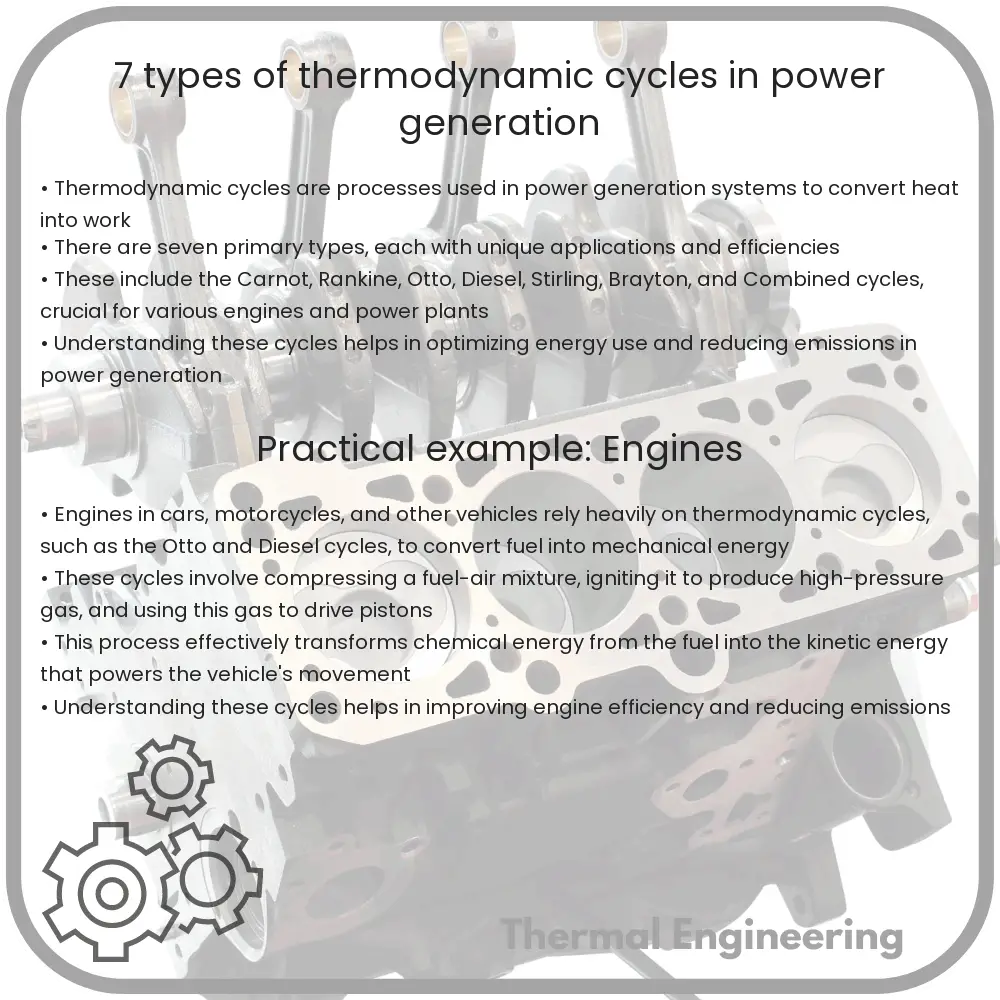Learn about thermodynamic cycles, the core processes behind power generation and how they convert energy into electricity.

Introduction to Thermodynamic Cycles in Power Generation
Thermodynamic cycles are the backbone of power generation systems, encompassing a series of processes through which a fluid undergoes changes in pressure, temperature, and state. These cycles are fundamental to understanding how energy is converted into electricity and useful work in various power plants. This article explores seven types of thermodynamic cycles commonly used in power generation.
1. Carnot Cycle
The Carnot cycle is a theoretical model that represents the maximum possible efficiency a heat engine can achieve under certain conditions. The cycle consists of two isothermal processes (heat transfer at constant temperature) and two adiabatic processes (heat transfer in which no energy is lost to the surroundings).
- Process 1-2: Isothermal expansion at temperature T1.
- Process 2-3: Adiabatic expansion, temperature drops from T1 to T2.
- Process 3-4: Isothermal compression at temperature T2.
- Process 4-1: Adiabatic compression, temperature rises from T2 to T1.
The efficiency of the Carnot cycle is given by $\eta = 1 – \frac{T_2}{T_1}$, where T1 and T2 are the temperatures of the hot and cold reservoirs, respectively.
2. Rankine Cycle
The Rankine cycle is the fundamental operating cycle for steam turbine systems used in power generation. It includes the following four primary processes:
- Process 1-2: Isentropic (constant entropy) compression of the working fluid in a pump.
- Process 2-3: Addition of heat at constant pressure in a boiler, which vaporizes water into steam.
- Process 3-4: Isentropic expansion through a turbine, generating work.
- Process 4-1: Rejection of heat in a condenser, converting steam back to liquid.
3. Brayton Cycle
Also known as the gas turbine cycle, the Brayton cycle is used in aircraft engines and gas turbine power plants. It consists of three main stages:
- Process 1-2: Isentropic compression of air in the compressor.
- Process 2-3: Constant pressure heat addition in the combustion chamber.
- Process 3-4: Isentropic expansion through a turbine to produce work.
4. Otto Cycle
Typical of spark ignition internal combustion engines, the Otto cycle includes four stages:
- Process 1-2: Isentropic compression of the air-fuel mixture in the combustion chamber.
- Process 2-3: Constant volume heat addition (ignition of fuel).
- Process 3-4: Isentropic expansion (power stroke).
- Process 4-1: Constant volume heat rejection (exhaust).
5. Diesel Cycle
The Diesel cycle is used in diesel engines and is characterized by its combustion process, which occurs at a constant pressure:
- Process 1-2: Isentropic compression of air (no fuel involved).
- Process 2-3: Constant pressure heat addition when the fuel is injected and combusted.
- Process 3-4: Isentropic expansion.
- Process 4-1: Constant volume heat rejection.
6. Stirling Cycle
The Stirling cycle is used in Stirling engines, known for their high efficiency and quiet operation. It involves isothermal and isochoric (constant volume) processes:
- Process 1-2: Isothermal expansion.
- Process 2-3: Isochoric cooling.
- Process 3-4: Isothermal compression.
- Process 4-1: Isochoric heating.
7. Combined Cycle
A combined cycle power plant integrates more than one thermodynamic cycle to achieve higher overall efficiency. Typically, it combines the Brayton cycle (for a gas turbine) and the Rankine cycle (for a steam turbine). Exhaust heat from the gas turbine is used to generate steam for the steam turbine, effectively utilizing the energy from fuel.
Understanding these thermodynamic cycles provides a foundation for exploring how various types of power plants operate and achieve energy conversion. Each cycle has its peculiarities and applications, making it fit for particular purposes in the field of power generation.